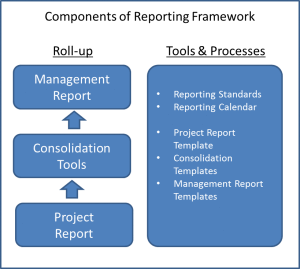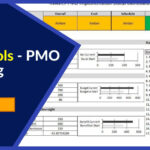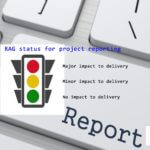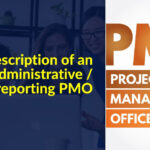A very important role of a project management office is to provide visibility of the status of all projects for which it has oversight. This is typically achieved through the mechanism of a PMO reporting framework.
This information is often used to update many stakeholders, many who will hold senior management positions. Therefore, it very important that the information is clear, concise and accurate.
Purpose of PMO reporting framework
In view of the importance of the data, it is important for the PMO to take the lead in creating a reporting framework to ensure that all reports are produced to the same set of standards and that there is a robust, efficient process to consolidate the date so as to produce an accurate, professional management report.
Approach
It is important that there is a mechanism to roll-up the project data from each project in a standard way to generate the summary reports. This is achieved through 4 steps:
Step 1 – Project Reporting
This is the process of each project producing a status report for their project. This is the most popular approach for reporting the current status, highlight areas of concern, etc. This will include the capture of any sub-work streams.
Step 2 – Review
The report must be reviewed and signed-off by the project manager before submission. If possible, the report should also be agreed with the project sponsor.
The PMO should then review the submissions to make sure that they are complete, make sense and to challenge. Part of the check is that the project has followed the defined reporting standards.
Checking the consistency to standards is very important. Senior management need to be able to trust the reports. They can only do this if they have confidence in the quality of the reports.
Step 3 – Consolidation
When the reports are reviewed, updated where required, and agreed, the PMO need to consolidate the project data. This allows data to be compared, reviewed and prepare it ready to be inserted into the management report.
Step 4 – Management report
The consolidated data is used to populate an overall summary report. This will present the key metrics and will quickly identify areas of concern and where action is required.
Tools and templates
There are a number of tools and templates that are used to support the reporting framework.
Project Report Template
This is a standard template to be used by all projects to report status on a periodic basis.
Consolidation Templates
This is used to take data elements from each of the project templates so that the data can be quickly and efficiently consolidated. For example, capturing all finance data to enable the production of overall progress against budget data. Using a defined consolidation process will help reduce errors and enable the process to be documented.
Management Report
This is used to present the consolidated data in a clear and concise format. For example, steering committee report.
Reporting Calendar
It is important that data can be compared in a consistent manner. Therefore, it is important that all projects produce their reports based on the same reporting schedule. This is achieved via a reporting calendar that publishes reporting cycles so everyone is clear on when reports need to be submitted and the cut-off date for the report. Read more about reporting calendars.
Reporting Standards
While the templates are the mechanism for reporting, at the centre are the reporting standards. This defines how the reporting process will work including definitions and values for the different data elements i.e. definition of the RAG status thresholds.
Summary
The PMO Reporting Framework is the tools and processes that define and support the complete reporting process. The purpose is to allow the efficient roll-up of data so as to produce professional, accurate (trusted) management reports.
You may want to look at my other posts covering different aspects of reporting such as PMO Dashboard.






